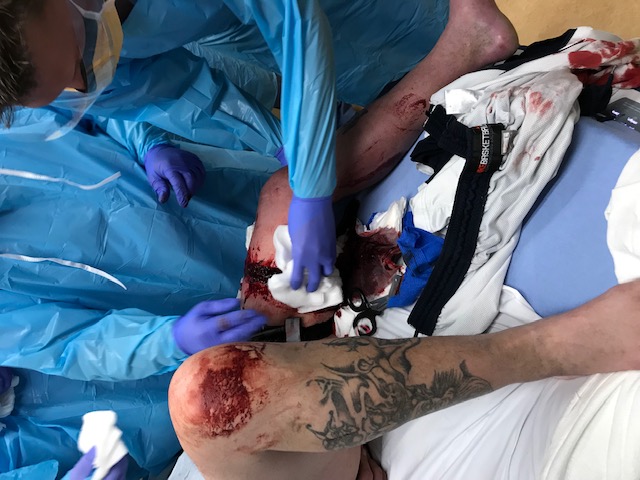COLORADO SPRINGS, Colo. (KDVR) — A man who required “multiple emergency surgeries” after a police canine bit through his leg, while he was naked in his bathroom in 2019, is suing the Colorado Springs Police Department in federal court, accusing officers of violating his Fourth Amendment rights.
“The law is that you have to use a reasonable amount of force for the situation that you’re encountering,” said David Lane, the civil rights attorney who represents John W. Mullins, the man who was bitten.
“It does not take a constitutional scholar to understand that if you’re in the shower and the police sic a police dog on you that rips your leg halfway off, maybe your rights were violated.”
According to records obtained by the FOX31 Problem Solvers, the incident happened in February 2019, after officers announced they had an arrest warrant for John Mullins and a search warrant at the home where Mullins had been living.
The probable cause statement for Mullins’ arrest shows officers were at Mullins’ home because Mullins was accused of committing identity theft and forgery crimes related to the burglary of a community mailbox.
Mullins is currently serving time in prison on related charges.
Body camera footage shows an officer shouting a warning to Mullins from an entrance of the home. “You need to come out now or a police dog will be released and you’re going to get bit,” he said.
After receiving no immediate response, the officer shouted again, “if you do not come out now, I cannot guarantee your safety and things will escalate.”
The officer eventually released the dog to search the home. Moments later, Mullins could be heard screaming and crying in pain when the dog found him and latched onto his upper thigh.
Lane said Mullins’ mother, who was home when police arrived to execute the warrants, said Mullins could not hear the warnings because he was in the shower.
“Not one person ever asked me where my son was,” said Carolyn Wright, Mullins’ mother. “All they had to do was ask me. I could have gone upstairs and got him, but they had their guns drawn and told me to sit in the car.”
A police probable cause statement said that another woman who was in the home when police arrived “initially told officers Mr. Mullins wasn’t home, but later advised officers Mr. Mullins was possibly inside the residence.”
In the suit, Lane alleges that officers “had no reason to believe that (Mullins) was a threat to anyone or was a threat to flee. The officers also knew that the crime they were arresting him for was a nonviolent one.”
When the defendants “saw the canine biting Mr. Mullins, they knew that he was naked, unarmed, and not resisting or threatening the canine or any officer. Even so, the officers did not immediately order the canine to stop biting Mr. Mullins,” the lawsuit said.
“He wasn’t going to run. He was naked. There was absolutely no justification to have a trained canine dog attack him,” said Wright.
The Colorado Springs Police Department said no internal affairs investigation occurred because no one filed a formal complaint at the time of the incident. A spokesperson declined to speak to the FOX31 Problem Solvers about the pending litigation.
A department spokesperson also declined to speak to the Problem Solvers about CSPD’s canine training procedures and policies because “that topic clearly – and directly – relates to this litigation and would be included in the same story,” said Natashia Kerr, a spokesperson for the department.
However, Kerr shared a copy of the policies with the Problem Solvers. The document refers to police canines as a “very effective tool” for locating and apprehending suspects while also pointing out “the likelihood of serious injury from a canine contact, compared to some other less lethal tools, is greater. Therefore, not all active resistance meets the ‘objectively reasonable’ standard for a canine deployment,” the general order policy states.
“Canine handlers are authorized to deploy a canine as a use of force if: Officers have grounds to arrest/detain the person and the person’s actions are at a level of active resistance which pose a risk to officers or others; or officers have grounds to arrest/detain the person and the person’s actions are at a level of active aggression; or the officer reasonably believes the person pose an imminent danger to others,” the policy states.
A dog handler “must conduct an overall assessment of the totality of the circumstances in determining the objective reasonableness of a canine deployment.”
According to the policy, that includes “the subject’s history of violence/resistance, including any past history of the subject being armed with a weapon; the subject’s current criminal charges (persons crimes/property crimes, felony/misdemeanor, armed, violent, etc.), including whether the subject is actively involved in a felony crime; whether the subject is in violation of parole conditions, information surrounding the subject’s mental state and/or likelihood of violent resistance and/or threat to the public; the subject’s failure to comply with officers’ orders to surrender; information and/or observations indicating a likelihood of violent resistance or danger to the public, the subject’s present ability to resist or present a danger to others.”
“Here they were encountering a guy that was wanted on a non-violent crime – stealing some mail,” said Lane. “You’re unleashing potentially deadly force in a situation that doesn’t require that kind of force.”
The Problem Solvers pulled Mullins recent Colorado criminal history and found several cases related to theft, forgery, and fraud.
One 2018 case involved accusations of a domestic violence assault incident. Someone reported seeing Mullins “slamming” a woman’s head against the steering wheel of a vehicle several times before pushing her out of the passenger side of the vehicle and then driving away.
Court records show the district attorney dismissed the assault charge and allowed Mullins to plead guilty to a felony menacing charge.
Despite this incident, Lane said police had no reason to suspect he would be violent with them during an arrest over the non-violent crimes for which he was wanted.
“John is a frequent-flyer in the courtroom. There was no reason to believe he was going to resist or fight or anything else,” said Lane. “To inflict life-threatening injuries on a guy wanted for stealing some mail is just absurd. He needed surgery. His leg still doesn’t function the way it used to. So, he has permanent injuries, nerve damage, because the Colorado Springs Police Department operates this way.”
Kyle Heyen, who runs Detector Dogs International, and has worked as a canine instructor and once served as a canine handler at the Laramie, WY police department, reviewed the videos and the court records obtained by the Problem Solvers.
“This is a perfect example of what should not happen,” he said.
Heyen told the Problem Solvers he has testified as an expert witness on behalf of law enforcement and for the people who have been bitten. “I testify to the facts of the case,” he said.
“If the facts are on the side of law enforcement, then I’m there, and I’m backing them. If the facts are for the person who is bitten, then I testify on that side.”
Heyen pointed out that the CSPD canine handler did appear to follow department protocol by giving warnings to Mullins and waiting for a response, but Heyen said “sending a dog into a residence is exactly what I taught my handlers not to do.”
Heyen said, “There are too many circumstances that can unfold, like, somebody’s in the shower and doesn’t hear anything.”
He also recounted an incident in which authorities in another jurisdiction deployed a police canine on a perceived intruder when really the alleged suspect was the guest of a teenaged girl who had invited her boyfriend to sneak into a back window. “They send the dog in there, bad things happen.”
Heyen said he could see that the CSPD officers were equipped with ballistic shields and prepared for various outcomes when they approached Mullins’ home.
He said they could have taken a different approach to the arrest.
“They believe him to be in the residence, and there are multiple officers there. They can surround that building,” he said. “Where would he go? If he leaves, they have a patrol dog. They can send the dog to apprehend him. If he has weapons and doesn’t comply, then they can deal with that. But they know where he is. Time is on their side. Why not try to negotiate, get a response from the person inside and move forward from there?”
He also said the injuries that were inflicted on Mullins could have been minimized.
“As soon as they saw that the man was being bitten – he didn’t have any weapons – obviously, he has no clothes on, nothing to hide anything anywhere, and both hands are holding onto the dog … had they, at that point in time, given a verbal command to let go of the man and come back to the handler … then automatically, the injuries would have been stopped,” said Heyen.
Heyen said the officers appeared to handcuff Mullins while the dog was still biting the suspect, even though Mullins was complying with their orders.
“They didn’t call the dog off,” said Heyen, who said the officer appeared to pull the dog’s collar while the dog was still biting.
“That action makes the dog bite harder,” he said. “It doesn’t make them let go. They bite harder -increasing the pain, increasing the injuries.”




